
The blotched emerald is a moth of the family Geometridae. The species was first described by Michael Denis and Ignaz Schiffermüller in 1775. It is found throughout Europe and the Near East. It has a scattered distribution in England and Wales, but is absent from Scotland and Ireland.

The blood-vein is a moth of the family Geometridae. The species was first described by Anton Schmidt in 1931.

The November moth is a moth of the family Geometridae. The species was first described by Michael Denis and Ignaz Schiffermüller in 1775. It can be found in the Palearctic realm in western Europe from central Scandinavia to the Mediterranean the Caucasus and western Russia.

The pale November moth is a moth of the family Geometridae. The species was first described by Allen in 1906. It is a fairly common species in Western Europe including the British Isles.
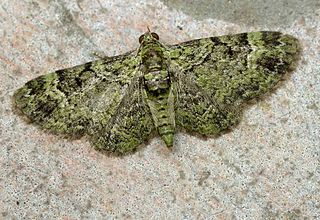
The green pug is a moth of the family Geometridae. It is sometimes placed in the genus Chloroclystis or Rhinoprora. It is common throughout the Palearctic region and the Near East, but also appears in North America.
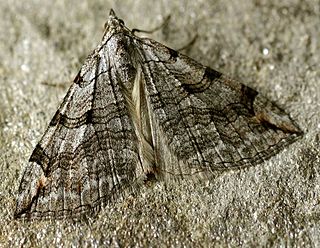
The treble-bar or St. John's wort inchworm is a moth of the family Geometridae. the species was first described by Carl Linnaeus in his 1758 10th edition of Systema Naturae. It is found throughout the Palearctic region and the Near East.

The feathered thorn is a moth of the family Geometridae. It was first described by Carl Linnaeus in 1761.

The vagrant darter is a European dragonfly. The species takes its English name from its habit of occasionally appearing as a rare vagrant north of its normal range. However, it is likely to be under-recorded because it is very similar to the common darter.

The dun-bar is a moth of the family Noctuidae. It is a common Palearctic species.
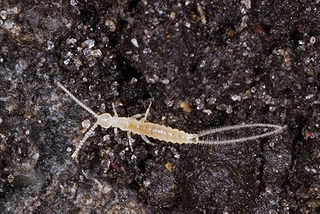
Campodea is a genus of small, white, bristle-tailed arthropods in the order Diplura. The best known species, Campodea staphylinus, has a wide distribution across much of Europe. It lives in damp places under stones, fallen trees, or in rotten wood and leaves. Although blind, it immediately crawls away on exposure to the light into the nearest crevice or other sheltered spot, feeling the way with its antennae. There are at least 130 described species in Campodea.

Incurvariidae is a family of small primitive monotrysian moths in the order Lepidoptera. There are twelve genera recognised. Many species are leaf miners and much is known of their host plants, excluding Paraclemensia acerifoliella. The most familiar species in Europe are perhaps Incurvaria masculella and Phylloporia bistrigella. The narrow wings are held tightly along the body at rest and some species have very long antennae.

Baetidae is a family of mayflies with about 1000 described species in 110 genera distributed worldwide. These are among the smallest of mayflies, adults rarely exceeding 10 mm in length excluding the two long slender tails and sometimes much smaller, and members of the family are often referred to as small mayflies or small minnow mayflies. Most species have long oval forewings with very few cross veins but the hindwings are usually very small or even absent. The males often have very large eyes, shaped like turrets above the head.
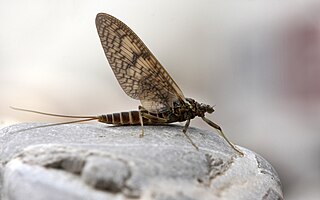
The Heptageniidae are a family of mayflies with over 500 described species mainly distributed in the Holarctic, Oriental, and Afrotropical regions, and also present in the Central American Tropics and extreme northern South America. The group is sometimes referred to as flat-headed mayflies or stream mayflies. These are generally rather small mayflies with three long tails. The wings are usually clear with prominent venation although species with variegated wings are known. As in most mayflies, the males have large compound eyes, but not divided into upper and lower parts.
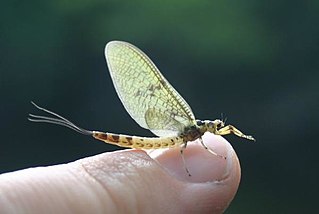
Ephemeridae is a family of mayflies with about 150 described species found throughout the world except Australia and Oceania. These are generally quite large mayflies with either two or three very long tails. Many species have distinctively patterned wings.

Dilta is a genus of primitive insects belonging to the family Machilidae. These insects are slender and wingless with dull, often mottled, colouring. They are typically found on the ground in heavily vegetated places. Dilta spp are restricted to western Europe and parts of north Africa.

Schinia, commonly called flower moths, is a large genus of moths belonging to the family Noctuidae. The genus has a Holarctic distribution with the vast majority of species being found in North America, many with a very restricted range and larval food plant.
Fauna Europaea is a database of the scientific names and distribution of all living multicellular European land and fresh-water animals. It serves as a standard taxonomic source for animal taxonomy within the Pan-European Species directories Infrastructure (PESI). As of June 2020, Fauna Europaea reported that their database contained 235,708 taxon names and 173,654 species names.

Graphomya maculata is a species of fly. It is widespread and common in most parts of Europe and also occurs in North Africa including the Canary Islands. The thorax bears the same black and white pattern in both sexes. Females also have a black and white abdomen, while the male has orange colouration on the abdomen as seen in the picture.

Dipsocoridae are a family of heteropteran bugs known as jumping ground bugs. There are about 30 widely distributed species which are placed in three genera. Fossils from Eocene amber have also been placed in the family.


















